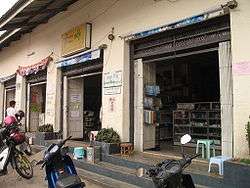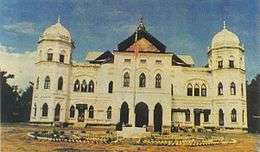Kengtung
| Kengtung Kyaingtong | |
|---|---|
| Town | |
|
The 'Sawbwa Palace, a historic landmark, was destroyed in November 9, 1991 by the Burmese government. | |
 Kengtung Location in Burma | |
| Coordinates: 21°17′30″N 99°36′30″E / 21.29167°N 99.60833°ECoordinates: 21°17′30″N 99°36′30″E / 21.29167°N 99.60833°E | |
| Country |
|
| Region | Shan State |
| District | Kengtung District |
| Township | Kengtung Township |
| Time zone | MST (UTC+6.30) |
Kengtung (Shan: ၵဵင်းတုင်; Burmese: ကျိုင်းတုံမြို့; MLCTS: kyuing: tum mrui., pronounced: [tɕáɪɴtòʊɴ mjo̰]; Thai: เชียงตุง, rtgs: Chiang Tung, pronounced [t͡ɕʰīaŋ tūŋ]; also spelled Kyaingtong, Chiang Tung, Cheingtung, and Kengtong) is a town in Shan State, Burma. It is the principal town of Kengtung Township. Kengtung is located on the National Highway 4 (NH4) and at the AH2 and AH3 of the Asian Highway.
The city is served by Kengtung Airport and it is home to the Kyaingtong Degree College.
Formerly located at the crossroads of the trade between China and Siam, Kengtung lost its importance owing to the international isolation of the military-ruled Burmese state.
History

The early history of Kengtung is made up of myths and legends. The oral tradition of the Wa people says that the ancient city of Kengtung was founded in the distant past by them as the original inhabitants of the region,[1] and was later reestablished by the grandson of King Mangrai after defeating the Wa.[2] This migration of the Chiang Mai dynasty in the 13th century, with the founding a new kingdom which was later named Lanna, has resulted in Kengtung having a different type of Tai population from the rest of the Shan State, the Tai Khün.
Kengtung, like other major towns in the Shan Plateau, was home to a Shan Saopha (Sawbwa). Kengtung was the capital of the Kengtung State, and had a palace, built by Sao Kawng Kiao Intaleng in 1905.
The city was occupied by the Thai Phayap Army from 1942 until the end of the Second World War and became the headquarters of the Saharat Thai Doem territory.[3] After the independence of Burma Kengtung suffered heavily from insurgency and military rule, followed by heavy cultural Burmanization. The headquarters of the regional military command of the Tatmadaw is in the town.[4]
Geography
Kengtung contains several lakes. The largest, Naung Tung Lake, lies in the western part of the city, followed by Naung Kham Lake and Naung Yarng Lake to the south of the Kentung Roman Catholic Mission.
Transportation
The town has an airport which offers domestic flights.
Climate
Kengtung has a tropical wet and dry/ savanna climate (Köppen-Geiger classification: Aw) with a pronounced dry season in the low-sun months , no cold season, wet season is in the high-sun months. Temperatures are very warm throughout the year, although the winter months (December-February) are milder and nights can be quite cool. There is a winter dry season (December-April) and a summer wet season (May-November).
| Climate data for Kengtung | |||||||||||||
|---|---|---|---|---|---|---|---|---|---|---|---|---|---|
| Month | Jan | Feb | Mar | Apr | May | Jun | Jul | Aug | Sep | Oct | Nov | Dec | Year |
| Average high °C (°F) | 26.7 (80.1) |
29.2 (84.6) |
32.0 (89.6) |
33.0 (91.4) |
32.3 (90.1) |
30.4 (86.7) |
29.6 (85.3) |
29.4 (84.9) |
29.6 (85.3) |
28.7 (83.7) |
27.2 (81) |
25.7 (78.3) |
29.48 (85.08) |
| Average low °C (°F) | 9.6 (49.3) |
10.8 (51.4) |
14.0 (57.2) |
18.2 (64.8) |
21.2 (70.2) |
22.1 (71.8) |
21.7 (71.1) |
21.5 (70.7) |
20.6 (69.1) |
18.6 (65.5) |
15.2 (59.4) |
11.0 (51.8) |
17.04 (62.69) |
| Average precipitation mm (inches) | 16.0 (0.63) |
8.0 (0.315) |
16.0 (0.63) |
43.0 (1.693) |
160.0 (6.299) |
175.0 (6.89) |
236.0 (9.291) |
243.0 (9.567) |
171.0 (6.732) |
128.0 (5.039) |
79.0 (3.11) |
23.0 (0.906) |
1,298 (51.102) |
| Source: HKO (1961-1990)[5] | |||||||||||||
See also
Bibliography
- Forbes, Andrew ; Henley, David (2011). Traders of the Golden Triangle. Chiang Mai: Cognoscenti Books. ASIN: B006GMID5
- J. G. Scott, Gazetteer of Upper Burma and the Shan States. 5 vols. Rangoon, 1900-1901.
- Sao Sāimöng Mangrāi, The Pādaeng Chronicle and the Kengtung State Chronicle Translated. University of Michigan, Ann Arbor, 1981
External links
| Wikimedia Commons has media related to Kengtung. |
- The Happy City, a 1959 film on a remote leper colony run by Father Cesare Columbo in Kengtung, Shan State
- pictures from Kengtung
References
- ↑ M. Fiskesjo, On the Ethnoarchaeology of Fortified Settlements in the Northern part of Mainland Southeast Asia
- ↑ History
- ↑ Shan and Karenni States of Burma
- ↑ Donald M. Seekins, Historical Dictionary of Burma (Myanmar), p. 251
- ↑ "Climatological Information for Kengtung, Myanmar". Hong Kong Observatory. Retrieved January 12, 2013.
| |||||||||||||||||||||||||||||||||||||||||||||||||||||||||||||||||||||||||||||||||||||||||


